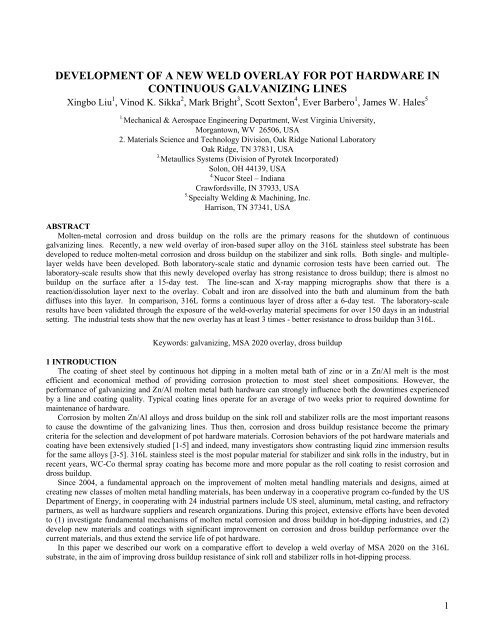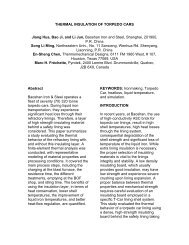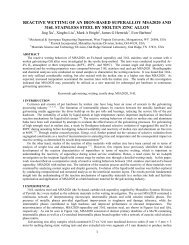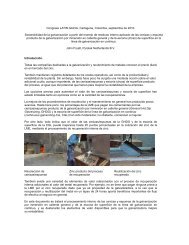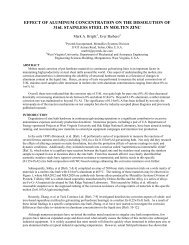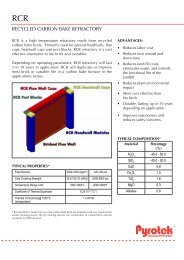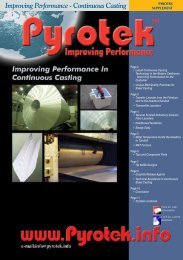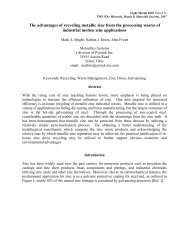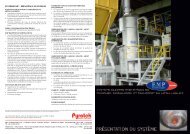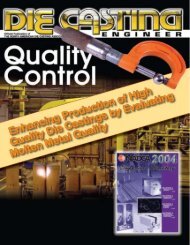development of a new weld overlay for pot hardware in ... - Pyrotek
development of a new weld overlay for pot hardware in ... - Pyrotek
development of a new weld overlay for pot hardware in ... - Pyrotek
Create successful ePaper yourself
Turn your PDF publications into a flip-book with our unique Google optimized e-Paper software.
DEVELOPMENT OF A NEW WELD OVERLAY FOR POT HARDWARE IN<br />
CONTINUOUS GALVANIZING LINES<br />
X<strong>in</strong>gbo Liu 1 , V<strong>in</strong>od K. Sikka 2 , Mark Bright 3 , Scott Sexton 4 , Ever Barbero 1 , James W. Hales 5<br />
1. Mechanical & Aerospace Eng<strong>in</strong>eer<strong>in</strong>g Department, West Virg<strong>in</strong>ia University,<br />
Morgantown, WV 26506, USA<br />
2. Materials Science and Technology Division, Oak Ridge National Laboratory<br />
Oak Ridge, TN 37831, USA<br />
3. Metaullics Systems (Division <strong>of</strong> <strong>Pyrotek</strong> Incorporated)<br />
Solon, OH 44139, USA<br />
4. Nucor Steel – Indiana<br />
Craw<strong>for</strong>dsville, IN 37933, USA<br />
5. Specialty Weld<strong>in</strong>g & Mach<strong>in</strong><strong>in</strong>g, Inc.<br />
Harrison, TN 37341, USA<br />
ABSTRACT<br />
Molten-metal corrosion and dross buildup on the rolls are the primary reasons <strong>for</strong> the shutdown <strong>of</strong> cont<strong>in</strong>uous<br />
galvaniz<strong>in</strong>g l<strong>in</strong>es. Recently, a <strong>new</strong> <strong>weld</strong> <strong>overlay</strong> <strong>of</strong> iron-based super alloy on the 316L sta<strong>in</strong>less steel substrate has been<br />
developed to reduce molten-metal corrosion and dross buildup on the stabilizer and s<strong>in</strong>k rolls. Both s<strong>in</strong>gle- and multiplelayer<br />
<strong>weld</strong>s have been developed. Both laboratory-scale static and dynamic corrosion tests have been carried out. The<br />
laboratory-scale results show that this <strong>new</strong>ly developed <strong>overlay</strong> has strong resistance to dross buildup; there is almost no<br />
buildup on the surface after a 15-day test. The l<strong>in</strong>e-scan and X-ray mapp<strong>in</strong>g micrographs show that there is a<br />
reaction/dissolution layer next to the <strong>overlay</strong>. Cobalt and iron are dissolved <strong>in</strong>to the bath and alum<strong>in</strong>um from the bath<br />
diffuses <strong>in</strong>to this layer. In comparison, 316L <strong>for</strong>ms a cont<strong>in</strong>uous layer <strong>of</strong> dross after a 6-day test. The laboratory-scale<br />
results have been validated through the exposure <strong>of</strong> the <strong>weld</strong>-<strong>overlay</strong> material specimens <strong>for</strong> over 150 days <strong>in</strong> an <strong>in</strong>dustrial<br />
sett<strong>in</strong>g. The <strong>in</strong>dustrial tests show that the <strong>new</strong> <strong>overlay</strong> has at least 3 times - better resistance to dross buildup than 316L.<br />
Keywords: galvaniz<strong>in</strong>g, MSA 2020 <strong>overlay</strong>, dross buildup<br />
1 INTRODUCTION<br />
The coat<strong>in</strong>g <strong>of</strong> sheet steel by cont<strong>in</strong>uous hot dipp<strong>in</strong>g <strong>in</strong> a molten metal bath <strong>of</strong> z<strong>in</strong>c or <strong>in</strong> a Zn/Al melt is the most<br />
efficient and economical method <strong>of</strong> provid<strong>in</strong>g corrosion protection to most steel sheet compositions. However, the<br />
per<strong>for</strong>mance <strong>of</strong> galvaniz<strong>in</strong>g and Zn/Al molten metal bath <strong>hardware</strong> can strongly <strong>in</strong>fluence both the downtimes experienced<br />
by a l<strong>in</strong>e and coat<strong>in</strong>g quality. Typical coat<strong>in</strong>g l<strong>in</strong>es operate <strong>for</strong> an average <strong>of</strong> two weeks prior to required downtime <strong>for</strong><br />
ma<strong>in</strong>tenance <strong>of</strong> <strong>hardware</strong>.<br />
Corrosion by molten Zn/Al alloys and dross buildup on the s<strong>in</strong>k roll and stabilizer rolls are the most important reasons<br />
to cause the downtime <strong>of</strong> the galvaniz<strong>in</strong>g l<strong>in</strong>es. Thus then, corrosion and dross buildup resistance become the primary<br />
criteria <strong>for</strong> the selection and <strong>development</strong> <strong>of</strong> <strong>pot</strong> <strong>hardware</strong> materials. Corrosion behaviors <strong>of</strong> the <strong>pot</strong> <strong>hardware</strong> materials and<br />
coat<strong>in</strong>g have been extensively studied [1-5] and <strong>in</strong>deed, many <strong>in</strong>vestigators show contrast<strong>in</strong>g liquid z<strong>in</strong>c immersion results<br />
<strong>for</strong> the same alloys [3-5]. 316L sta<strong>in</strong>less steel is the most popular material <strong>for</strong> stabilizer and s<strong>in</strong>k rolls <strong>in</strong> the <strong>in</strong>dustry, but <strong>in</strong><br />
recent years, WC-Co thermal spray coat<strong>in</strong>g has become more and more popular as the roll coat<strong>in</strong>g to resist corrosion and<br />
dross buildup.<br />
S<strong>in</strong>ce 2004, a fundamental approach on the improvement <strong>of</strong> molten metal handl<strong>in</strong>g materials and designs, aimed at<br />
creat<strong>in</strong>g <strong>new</strong> classes <strong>of</strong> molten metal handl<strong>in</strong>g materials, has been underway <strong>in</strong> a cooperative program co-funded by the US<br />
Department <strong>of</strong> Energy, <strong>in</strong> cooperat<strong>in</strong>g with 24 <strong>in</strong>dustrial partners <strong>in</strong>clude US steel, alum<strong>in</strong>um, metal cast<strong>in</strong>g, and refractory<br />
partners, as well as <strong>hardware</strong> suppliers and research organizations. Dur<strong>in</strong>g this project, extensive ef<strong>for</strong>ts have been devoted<br />
to (1) <strong>in</strong>vestigate fundamental mechanisms <strong>of</strong> molten metal corrosion and dross buildup <strong>in</strong> hot-dipp<strong>in</strong>g <strong>in</strong>dustries, and (2)<br />
develop <strong>new</strong> materials and coat<strong>in</strong>gs with significant improvement on corrosion and dross buildup per<strong>for</strong>mance over the<br />
current materials, and thus extend the service life <strong>of</strong> <strong>pot</strong> <strong>hardware</strong>.<br />
In this paper we described our work on a comparative ef<strong>for</strong>t to develop a <strong>weld</strong> <strong>overlay</strong> <strong>of</strong> MSA 2020 on the 316L<br />
substrate, <strong>in</strong> the aim <strong>of</strong> improv<strong>in</strong>g dross buildup resistance <strong>of</strong> s<strong>in</strong>k roll and stabilizer rolls <strong>in</strong> hot-dipp<strong>in</strong>g process.<br />
1
2 EXPERIMENTAL<br />
2.1 Materials Development<br />
316L sta<strong>in</strong>less steel and MSA 2020, an iron-based superalloy, which conta<strong>in</strong>s a cont<strong>in</strong>uous microscopic network <strong>of</strong><br />
<strong>in</strong>terpenetrat<strong>in</strong>g microscopic <strong>in</strong>termetallic phases and solid solution metallic phases, was employed <strong>in</strong> this research. The<br />
presence <strong>of</strong> metallic phases <strong>in</strong> MSA 2020 provides significant improvement <strong>in</strong> toughness and damage tolerance, while the<br />
<strong>in</strong>termetallic phases would lead to high hardness and improved per<strong>for</strong>mance at elevated temperatures. However, to employ<br />
this alloy <strong>in</strong> the applications <strong>of</strong> s<strong>in</strong>k and stabilizer rolls, a special metal <strong>in</strong>ert gas (MIG) <strong>weld</strong><strong>in</strong>g process was developed to<br />
apply this alloy as a coat<strong>in</strong>g on 316L substrate.<br />
2.2 Corrosion and Dross Buildup Test<strong>in</strong>g<br />
There were totally three k<strong>in</strong>ds <strong>of</strong> tests carried out dur<strong>in</strong>g this research: lab-scale static corrosion test, lab-scale dynamic<br />
dross buildup test, and corrosion/dross buildup test <strong>in</strong> <strong>in</strong>dustrial galvaniz<strong>in</strong>g baths.<br />
Static corrosion/dross buildup tests were conducted <strong>in</strong> a lab-scale z<strong>in</strong>c bath conta<strong>in</strong><strong>in</strong>g alum<strong>in</strong>um with the percentage<br />
rang<strong>in</strong>g from 0.19% to 0.22% (GI) at temperatures <strong>of</strong> around 460 ± 5ºC. The GI alloy <strong>in</strong>gots were provided by Wheel<strong>in</strong>g<br />
Nissh<strong>in</strong> Co. at Follansbee, WV. The chemical compositions <strong>of</strong> the <strong>in</strong>gots are: 99.98Zn, 0.011Si, 0.003 Al, 0.002Fe, 0.002Pb.<br />
Dynamic dross buildup tests were conducted by rotat<strong>in</strong>g samples, 316L and MSA 2020 <strong>overlay</strong>, <strong>in</strong> a lab-scale<br />
galvaniz<strong>in</strong>g bath with 80-lbs molten Zn-Al alloy, <strong>for</strong> up to 15 days. Similar to the static tests, Al contents were around<br />
0.20% and temperature was set at 460ºC. The alloy <strong>in</strong>gots were saturated with Fe.<br />
Industrial tests were conducted by dipp<strong>in</strong>g the samples <strong>in</strong> four galvaniz<strong>in</strong>g l<strong>in</strong>es <strong>for</strong> up to 150 days.<br />
After each test, cross-sectional metallographic samples were prepared follow<strong>in</strong>g a standard procedure. The identification<br />
<strong>of</strong> some reaction products was conducted us<strong>in</strong>g a JOEL 8200 Electron Probe Micro Analyzer (EPMA). Details <strong>of</strong> the<br />
reaction products <strong>in</strong> the samples were exam<strong>in</strong>ed us<strong>in</strong>g a HITACHI 4700 Scann<strong>in</strong>g Electron Microscope (SEM) equipped<br />
with an EDS unit. The depths <strong>of</strong> reaction layers were then measured us<strong>in</strong>g image analysis s<strong>of</strong>tware (Image-Pro Plus 4.0).<br />
3 RESULTS and DISCUSSIONS<br />
3.1 MSA 2020 Overlay<br />
In order to carry out the <strong>weld</strong> <strong>overlay</strong>s <strong>of</strong> 2020, its wire was produced by Stoody Co. by the powder core approach.<br />
This is the first time such a filler wire was ever produced. Multiple pass <strong>weld</strong>s were prepared us<strong>in</strong>g this wire on type 316L<br />
plate. Two <strong>weld</strong> samples were prepared, each us<strong>in</strong>g a metal <strong>in</strong>ert gas (MIG) process. The detailed microstructural analysis<br />
<strong>of</strong> one <strong>of</strong> the multiple pass <strong>weld</strong>s <strong>of</strong> 2020 on type 316L is shown <strong>in</strong> Figure2. Prior to mak<strong>in</strong>g multiple pass <strong>weld</strong>s, a s<strong>in</strong>gle<br />
pass <strong>weld</strong> was also prepared. The microhardness data <strong>for</strong> the s<strong>in</strong>gle and multiple pass <strong>weld</strong>s were measured and it can be<br />
found from hardness measurement that there are four regions <strong>in</strong> the <strong>overlay</strong>: <strong>weld</strong> top (MSA 2020), <strong>in</strong>termix region,<br />
<strong>in</strong>terface, and substrate (type 316L). In the multiple pass <strong>weld</strong>s, surface hardness was maximum and reached average<br />
values <strong>of</strong> ~ 575 Vicker’s. In the s<strong>in</strong>gle pass <strong>weld</strong> where the <strong>weld</strong> surface is diluted, its hardness was ~ 480 Vicker’s.<br />
3.2 Corrosion and Dross Buildup Resistance<br />
Static Corrosion<br />
Figure 2: Top <strong>of</strong> <strong>weld</strong> <strong>overlay</strong> specimen.<br />
2
Figure 3 shows the lab-scale static corrosion <strong>of</strong> MSA 2020 <strong>in</strong> galvaniz<strong>in</strong>g bath, as compared to 316L sta<strong>in</strong> steel. It is<br />
<strong>in</strong>dicated <strong>in</strong> the figure that the average thickness lost <strong>of</strong> the <strong>overlay</strong> is 2mm after submerged <strong>in</strong> the bath <strong>for</strong> 895 hours, while<br />
the sta<strong>in</strong>less steel lost 8mm dur<strong>in</strong>g the same test<strong>in</strong>g period.<br />
Corrsion (<strong>in</strong>)<br />
0.035<br />
0.03<br />
0.025<br />
0.02<br />
0.015<br />
0.01<br />
0.005<br />
0<br />
143h<br />
Steel<br />
895h<br />
143h<br />
Alloy 2020 Bead #<br />
Sample 1<br />
143h<br />
Alloy 2020 Bead # 2<br />
Figure 3: Lab-scale static corrosion <strong>of</strong> 316L and MSA 2020 <strong>overlay</strong>.<br />
Dynamic Dross Buildup<br />
Figure 5 shows the SEM micrographs <strong>of</strong> 316L sta<strong>in</strong>less steel samples after lab-scale dynamic test <strong>in</strong> Zn-0.22%Al bath<br />
<strong>for</strong> 2 days and 6 days. It is <strong>in</strong>dicated <strong>in</strong> figure 5(a) that after 2 days dynamic test, there is a cont<strong>in</strong>uous <strong>in</strong>ternal reaction layer<br />
with the thickness around 5 micron, which provides the favorable position <strong>for</strong> the buildup <strong>of</strong> big dross particles from the<br />
bath, but the dross buildup layer is semi-cont<strong>in</strong>uous. By comparison, after 6 days <strong>of</strong> dynamic rotat<strong>in</strong>g test, there is a dense<br />
cont<strong>in</strong>uous dross buildup layer on the surface <strong>of</strong> the steel. In addition, by compar<strong>in</strong>g dynamic results with static ones, it can<br />
be concluded that (1) the reaction layer after dynamic test is much thicker than that after static test; (2) the size <strong>of</strong> dross<br />
particles is bigger than that after static test; and (3) the agglomeration <strong>of</strong> dross particles is faster than that after static test.<br />
(a) 2 days (b) 6 days<br />
Figure 5 Dynamic dross buildup tests on 316L sta<strong>in</strong>less <strong>in</strong> GI bath at 465ºC (rotat<strong>in</strong>g rate 60 rpm).<br />
Figure 6 shows the l<strong>in</strong>e-scan <strong>of</strong> MSA 2020 <strong>overlay</strong> after lab-scale dynamic test <strong>for</strong> 15 days. It is <strong>in</strong>dicated that this<br />
<strong>new</strong>ly developed <strong>overlay</strong> has strong resistance to the dross buildup and there is very few Fe-Al(Zn) dross particles attached<br />
to the surface. Figure 7 shows the X-day maps <strong>of</strong> the reaction layer on the top <strong>of</strong> the <strong>overlay</strong>. The l<strong>in</strong>e-scan (Figure 6) and<br />
X-ray mapp<strong>in</strong>g (Figure 7) micrographs show that there is a reaction/dissolution layer next to the <strong>overlay</strong>, with<strong>in</strong> which Co<br />
and Fe dissolved <strong>in</strong>to the bath and Al from bath diffuses <strong>in</strong>to this layer, with<strong>in</strong> which cobalt and iron are dissolved <strong>in</strong>to the<br />
bath and alum<strong>in</strong>um from the bath diffuses <strong>in</strong>to this layer.<br />
895h<br />
895h<br />
3
Wt.%<br />
80<br />
70<br />
60<br />
50<br />
40<br />
30<br />
20<br />
10<br />
0<br />
0 10 20 30 40 50 60 70<br />
Microns<br />
Figure 6: L<strong>in</strong>e-scan <strong>of</strong> MSA 2020 <strong>overlay</strong> after 15-day dynamic test.<br />
(a) BSI (b) Co<br />
(c) Al (d) Fe<br />
Figure 7: BSI image and X-ray mapp<strong>in</strong>g <strong>of</strong> Co, Al & Fe <strong>of</strong> the reaction area.<br />
3.3 Test<strong>in</strong>g Results <strong>in</strong> Industrial Baths<br />
Figure 8 shows the 316L sta<strong>in</strong>less steel and MSA 2020 <strong>overlay</strong> after dipped <strong>in</strong> Nucor-Craw<strong>for</strong>dsville <strong>for</strong> 81 days. A<br />
detailed microstructural analysis <strong>of</strong> the sections taken from 316L and 2020 <strong>weld</strong> <strong>overlay</strong> was carried out, which <strong>in</strong>cluded<br />
optical microstructure, microhardness, and microprobe analysis. From this figure we made the follow<strong>in</strong>g observations:<br />
a) 316L surface had a thick dross deposit and a narrow reacted layer underneath. The <strong>in</strong>terface between the dross and<br />
316L surface was rough, <strong>in</strong>dicat<strong>in</strong>g a dissolution type <strong>of</strong> mechanism occurr<strong>in</strong>g at the surface.<br />
b) For 2020 <strong>weld</strong> <strong>overlay</strong>, there was a very th<strong>in</strong> layer <strong>of</strong> dross and a larger reaction layer underneath. Furthermore,<br />
the <strong>in</strong>terface underneath the dross was smooth, <strong>in</strong>dicat<strong>in</strong>g the absence <strong>of</strong> any dissolution type <strong>of</strong> mechanism at the <strong>in</strong>terface.<br />
O<br />
Ni<br />
Al<br />
Si<br />
W<br />
Zn<br />
Mo<br />
Fe<br />
Cr<br />
4
Both 33- and 81-day exposed samples were also subjected to microprobe analysis. The results <strong>of</strong> the microprobe scans<br />
after 81 days are compared <strong>for</strong> 316L and 2020 <strong>weld</strong> <strong>overlay</strong>. The elemental scans show the variation <strong>of</strong> different alloy<strong>in</strong>g<br />
elements <strong>in</strong> the reaction layer. A comparison <strong>of</strong> the two scans shows that the reaction layers <strong>for</strong> both 316L and 2020 consist<br />
<strong>of</strong> Al, Fe, Zn, O, and small amounts <strong>of</strong> other alloy<strong>in</strong>g elements. The reaction layer <strong>for</strong> 316L is richer <strong>in</strong> Al and Fe as<br />
opposed to 2020 <strong>weld</strong> <strong>overlay</strong>. The reaction layer <strong>for</strong> 2020 conta<strong>in</strong>ed less amounts <strong>of</strong> Al and Fe but conta<strong>in</strong>ed Co, Cr, and<br />
Si. It is not clear at this time how the reaction layer composition <strong>in</strong> 2020 <strong>weld</strong> <strong>overlay</strong>, which is nearly the same after 81<br />
days, retards the dross build-up as opposed to 316L. It is suggested that there are <strong>in</strong>itial differences <strong>in</strong> reaction layer<br />
composition between 316L and 316L/2020. However, after 81 days, reaction layer <strong>for</strong> 316L and 316L/2020 consists<br />
essentially <strong>of</strong> the same composition as Al5Fe2Zn1. Future work on wettability studies and other <strong>in</strong>-plant tests may help to<br />
understand the noted differences more clearly.<br />
Dross<br />
444.5 µm<br />
Dross<br />
Reaction Layer<br />
316L 316L + 2020<br />
Reaction Layer<br />
Figure 8: 316L and 2020 <strong>weld</strong> <strong>overlay</strong> tubes after 81 days <strong>of</strong> GI-bath exposure at Nucor Steel-Craw<strong>for</strong>dsville plant.<br />
Table I: Dross and Reaction Data on All In-plant Trial Samples <strong>of</strong> 316L and 316L/2020<br />
Microstructural analysis <strong>of</strong> specimens exposed <strong>for</strong> 30, 90, 150, and 174 days was carried out. The dross and reaction<br />
data <strong>for</strong> all <strong>of</strong> the specimens analyzed to date are summarized <strong>in</strong> Table I. These data show that the reaction depth can be<br />
given by:<br />
Reaction depth (R) = Ae Bt , (1)<br />
where A and B = constants,<br />
t = bath exposure time <strong>in</strong> days.<br />
The values <strong>of</strong> constant B <strong>for</strong> 316L and 316L/2020 were 0.012 and 0.016, respectively, and the values <strong>of</strong> constant A <strong>for</strong><br />
316L and 316L/2020 were 18.2 and 24.7, respectively. This suggests that at time zero or <strong>in</strong>itial contact with molten z<strong>in</strong>c, the<br />
63.5 µm<br />
Dross<br />
5
2020 surface reacted quickly and then it grew at a rate very similar to that <strong>of</strong> 316L. The rapid <strong>for</strong>mation <strong>of</strong> the <strong>in</strong>itial<br />
reaction may be responsible <strong>for</strong> less dross <strong>for</strong>mation on 316L/2020.<br />
A general equation <strong>for</strong> dross, D, can be given as:<br />
D = A′e -0.005t , (2)<br />
where A′ = the constant and its values are 387 and 185, respectively, <strong>for</strong> 316L and 316L/2020.<br />
t = time <strong>in</strong> days.<br />
Equations (1) and (2) and the respective constants were used to calculate the dross plus reaction build-up on 316L and<br />
316L/2020. It can be found that if 7 mil <strong>of</strong> the <strong>weld</strong>-<strong>overlay</strong> surface is removed every 60 days, the 316L/2020 will cont<strong>in</strong>ue<br />
to outper<strong>for</strong>m 316L. Furthermore, at a removal rate <strong>of</strong> 7 mil/60 days, a 3.5-mm (140-mil) –thick <strong>weld</strong> <strong>overlay</strong> will last over<br />
three years with significantly improved per<strong>for</strong>mance over 316L<br />
5 CONCLUSIONS<br />
In this research, a <strong>new</strong> <strong>weld</strong> <strong>overlay</strong> <strong>of</strong> MSA 2020, an iron-based super alloy, on the 316L sta<strong>in</strong>less steel substrate has<br />
been developed to reduce molten-metal corrosion and dross buildup on the stabilizer and s<strong>in</strong>k rolls. Both s<strong>in</strong>gle- and multilayer<br />
<strong>weld</strong>s have been developed. Both laboratory-scale static and dynamic corrosion tests have been carried out. The<br />
follow<strong>in</strong>g conclusions can be drawn:<br />
(1) This <strong>new</strong>ly developed <strong>overlay</strong> has strong resistance to dross buildup; there is almost no buildup on the surface<br />
after a 15-day test. In comparison, 316L <strong>for</strong>ms a cont<strong>in</strong>uous layer <strong>of</strong> dross after a 6-day test.<br />
(2) The l<strong>in</strong>e-scan and X-ray mapp<strong>in</strong>g micrographs show that there is a reaction/dissolution layer next to the<br />
<strong>overlay</strong>. Cobalt and iron are dissolved <strong>in</strong>to the bath and alum<strong>in</strong>um from the bath diffuses <strong>in</strong>to this layer.<br />
(3) Industrial tests <strong>in</strong> various galvaniz<strong>in</strong>g l<strong>in</strong>es show that this <strong>overlay</strong> is a candidate <strong>for</strong> next generation coat<strong>in</strong>g on<br />
s<strong>in</strong>k and stabilizer rolls <strong>in</strong> hot-dipp<strong>in</strong>g processes.<br />
ACKNOWLEDGEMENTS<br />
This research was sponsored by the U.S. Department <strong>of</strong> Energy, Office <strong>of</strong> Energy Efficiency and Re<strong>new</strong>able Energy,<br />
Industrial Technologies Program, under contract DE-FC36-04GO14038. The authors would like to thank Dr. Frank<br />
Goodw<strong>in</strong> from International Lead Z<strong>in</strong>c Research Organization <strong>for</strong> his technical contribution and cont<strong>in</strong>uous encouragement.<br />
Thanks are due to Frank Mollica <strong>of</strong> Wheel<strong>in</strong>g Nissh<strong>in</strong> Inc. who provided galvaniz<strong>in</strong>g <strong>in</strong>gots. Ms. J<strong>in</strong>g Xu conducted labscale<br />
static and dynamic tests <strong>of</strong> 316L and MSA 2020 <strong>overlay</strong>, and the subsequencial microstructural analysis.<br />
REFERENCE:<br />
1) K. Zhang, N.-Y. Tang: Galvatech '04: 6th International Conference on Z<strong>in</strong>c and Z<strong>in</strong>c Alloy Coated Steel Sheet -<br />
Conference Proceed<strong>in</strong>gs, Chicago, (2004), 617 – 627.<br />
2) V. Parthasarathy, B.S.-J. Kang, A. Krishnaswamy, E. Barbero, K.M. Chang, C. Irw<strong>in</strong>, F. Goodw<strong>in</strong>: Galvatech '04: 6th<br />
International Conference on Z<strong>in</strong>c and Z<strong>in</strong>c Alloy Coated Steel Sheet - Conference Proceed<strong>in</strong>gs, Chicago, (2004), 637-<br />
655<br />
3) W.J. Wang, J.P. L<strong>in</strong>, Y.L. Wang, and G.L. Chen: Journal <strong>of</strong> University <strong>of</strong> Science and Technology Beij<strong>in</strong>g: M<strong>in</strong>eral<br />
Metallurgy Materials (Eng Ed), 14 (2007), 52-55<br />
4) K. Zhang, N.-Y. Tang: Materials Science and Technology, 20(2004), 739-746<br />
5) M.S. Brunnock, R.D. Jones, G.A. Jenk<strong>in</strong>s, and D.T. Llewellyn: Ironmak<strong>in</strong>g and Steelmak<strong>in</strong>g, 24(1997), 40-46<br />
6


